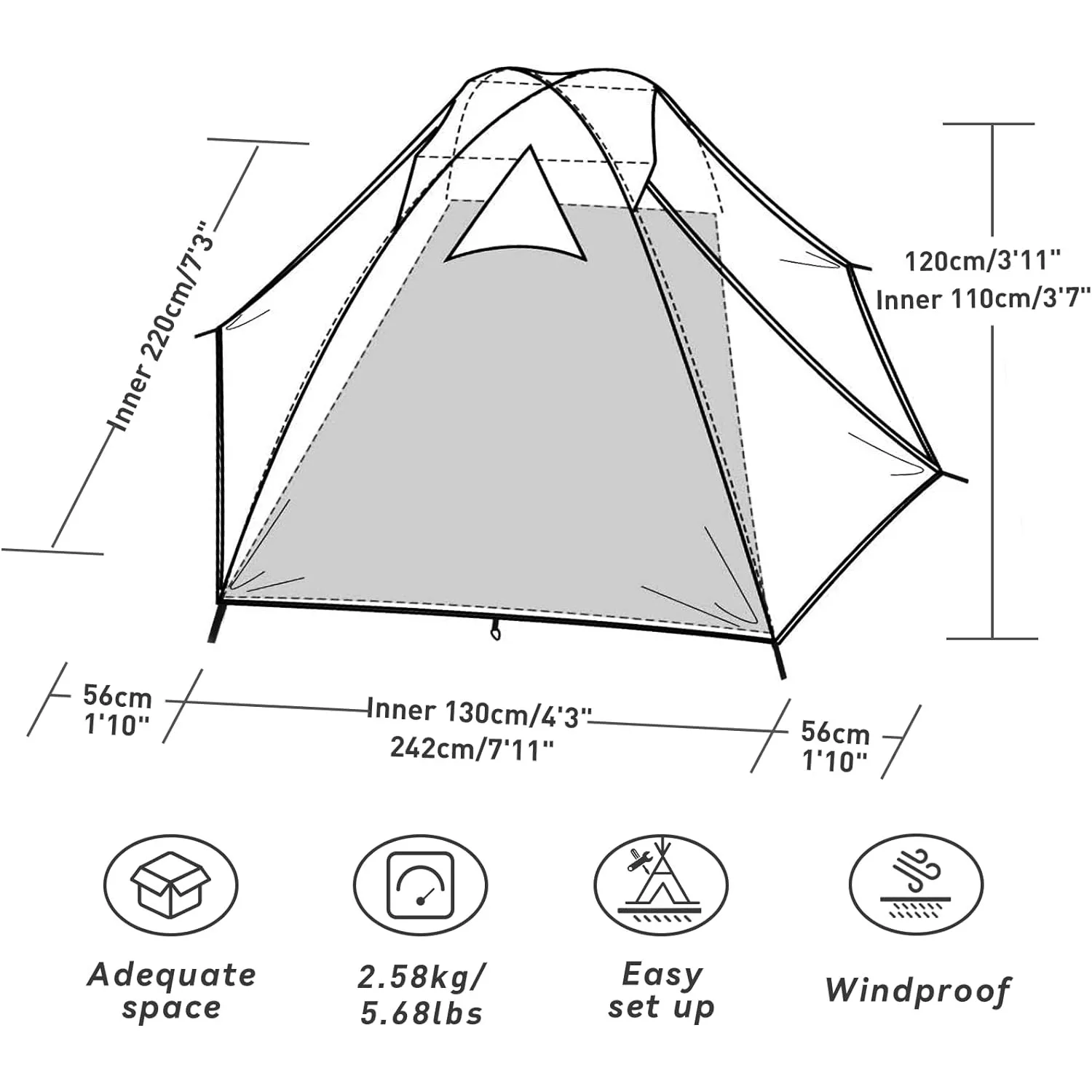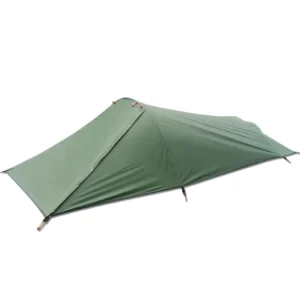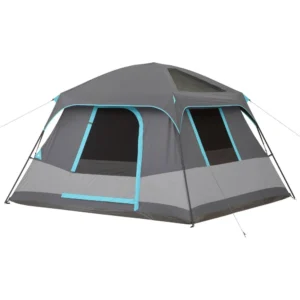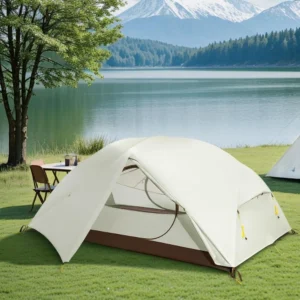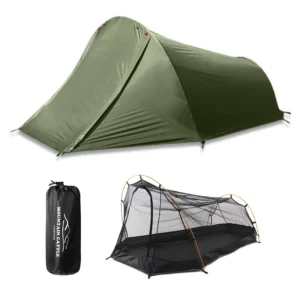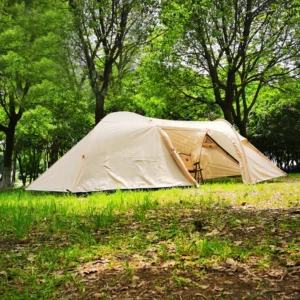Introduction: Understanding the Freestanding Shelter Advantage
When preparing for hiking adventures, selecting the right shelter can feel overwhelming. With numerous options available, understanding the key differences becomes crucial for making the best choice for your specific needs.
Freestanding shelters are distinguished by their integrated pole structure that allows them to stand completely on their own without requiring stakes. This means you can set up the tent and move it as a complete unit before securing it to the ground—a feature that sets them apart from their non-freestanding counterparts.
Despite typically weighing more than ultralight alternatives, many experienced hikers still opt for freestanding shelters. Why? The advantages these structures offer often outweigh the extra ounces for many outdoor enthusiasts:
- Greater versatility across diverse environments
- Simplified setup process
- Enhanced weather protection
- Superior comfort features
The benefits of freestanding shelters become particularly evident in challenging environments like desert landscapes with loose sand, alpine zones with rocky terrain, and established campgrounds with wooden platforms. Understanding these advantages helps determine if these freestanding shelters for hikers align with your outdoor needs.
As we explore these benefits in detail, we’ll also acknowledge the trade-offs involved, helping you make an informed decision based on your hiking style and priorities. The fundamental freestanding tent structure creates unique advantages that many hikers find invaluable in the backcountry.
Adaptable to Any Terrain: The Ultimate Setup Flexibility
One of the most compelling advantages of freestanding shelters is their remarkable terrain adaptability. This flexibility solves a common problem that hikers face: finding a suitable spot to pitch camp when the ground isn’t ideal.
Freestanding shelters excel on surfaces that would challenge or completely defeat non-freestanding designs:
- Rocky surfaces and slickrock areas – Where driving stakes is impossible
- Sandy beaches and desert environments – Where stakes easily pull out of loose substrate
- Wooden platforms at designated campsites – Where staking isn’t an option
- Hard-packed ground – That resists stake penetration
- Shallow soil over bedrock – Where stakes can’t penetrate deeply enough
This versatility significantly expands your campsite options, reducing the stress of finding the “perfect spot” at the end of a long hiking day. You can set up on surfaces that would be impossible for tents requiring staking to establish their basic structure.
While freestanding tents don’t require stakes to maintain their shape, it’s important to note that staking is still recommended whenever possible. Stakes provide additional stability, especially in windy conditions, preventing your shelter from becoming a tumbling hazard across the campsite.
For hikers who frequently venture into areas with challenging terrain, this adaptability proves invaluable. Alpine environments above treeline, desert landscapes, and established campgrounds with wooden platforms all become viable options for comfortable camping with freestanding tent options designed for rocky terrain.
The terrain flexibility alone makes freestanding backpacking tents worth considering, particularly if your adventures take you across diverse landscapes where pitching conditions vary dramatically.
Quick Setup in Minutes: Time and Energy Saved
Setting up camp quickly can be crucial, especially when weather conditions deteriorate or daylight fades. Freestanding shelters offer a significant advantage in setup speed and simplicity compared to their non-freestanding counterparts.
The integrated pole system of freestanding shelters creates immediate structure, eliminating the need for precise staking to achieve the basic tent form. This design difference results in several key benefits:
- Structure forms before staking, allowing for position adjustments
- Less precision required in initial placement
- Fewer steps between unpacking and having shelter
Most freestanding designs feature intuitive pole systems with color-coding or logical connection points that make assembly straightforward even for beginners. This simplicity translates to valuable time savings—often reducing setup time to just 3-5 minutes once familiar with the process.
This quick setup advantage becomes particularly valuable in challenging scenarios:
* During sudden rainstorms when staying dry is urgent
* When arriving at camp after dark and setting up by headlamp
* After an exhausting day when energy reserves are low
The learning curve for setting up freestanding shelters tends to be shorter for beginners compared to tarp systems or non-freestanding tents that require practiced staking patterns. This accessibility makes best freestanding hiking shelters popular choices for those new to backpacking.
For those prioritizing convenience, easy-setup camping tents offer refined designs that further streamline the process, allowing you to focus more on enjoying your surroundings and less on complicated setup procedures.
The Perfect Position: Ability to Move After Setup
Perhaps one of the most unique advantages of freestanding shelters is the ability to reposition your fully assembled tent. Once set up, you can simply lift the entire structure and move it to a different location without disassembling it—a feature impossible with staked designs.
This repositioning ability proves valuable in numerous common scenarios:
- Finding a flatter spot after noticing your initial location has an uncomfortable slope
- Adjusting for better views or to take advantage of natural features
- Optimizing sun exposure or shade based on time of day
- Moving away from discovered hazards like ant hills, sharp rocks, or water runoff paths
This feature allows for campsite fine-tuning without the frustration of complete disassembly and reassembly. You can test different positions around your chosen area to find the optimal spot for comfort, views, or protection from elements.
The ability to lift and move your shelter also offers a practical cleaning advantage. Before final staking, you can easily shake out dirt, pine needles, sand, or other debris that may have accumulated during setup—ensuring a cleaner sleeping area.
For those concerned about finding the perfect camping spot, waterproof camping tents with freestanding designs combine this positioning flexibility with reliable protection from the elements—a powerful combination for optimizing your backcountry experience.
Enhanced Weather Protection: Built to Withstand the Elements
Freestanding shelters offer superior weather protection thanks to their robust pole structure that creates stability even before staking. This architectural advantage proves particularly valuable in challenging conditions that test the limits of shelter design.
The rigid pole structure of freestanding tents provides several weather-related benefits:
Superior Stability: The interconnected pole system creates a stable framework that better resists deformation from wind pressure compared to many non-freestanding alternatives.
Double-Wall Design: Most freestanding tents feature a double-wall construction with separate tent body and rainfly, creating an additional barrier against moisture and temperature fluctuations.
Taut Pitch: The self-supporting structure achieves a naturally taut pitch that effectively sheds rain and snow without sagging.
Even Tensioning: Proper tensioning is easier to achieve with a freestanding structure, eliminating weak points that could compromise weather resistance.
This enhanced stability proves particularly valuable during unexpected weather events. Heavy rainfall slides more effectively off properly tensioned rainflies, while strong winds meet a more resilient structure. Many freestanding designs even incorporate crossing poles or additional support points specifically engineered to withstand challenging conditions.
For those frequently camping in areas known for unpredictable weather, understanding freestanding tent stability in windy conditions becomes crucial for selecting appropriate gear. The security of a shelter that maintains its integrity during overnight storms brings invaluable peace of mind.
While evaluating shelters, it’s also worth understanding waterproof ratings in backpacking gear to ensure your chosen model provides adequate protection for your typical conditions. The structural advantages of freestanding designs work in concert with waterproof materials to create comprehensive weather protection.
Maximized Interior Space: Comfort Beyond Just Shelter
Freestanding shelters typically offer superior interior living space compared to many ultralight alternatives, thanks to their pole structure that creates more vertical walls and defined internal volume. This architectural advantage translates directly to comfort during extended time in your shelter.
Key space advantages include:
- Vertical side walls that maximize usable interior volume rather than sloping immediately from center
- Strategic pole placement that creates defined living space with better headroom
- Optimized floor dimensions that utilize the entire footprint effectively
These design elements significantly impact the practical experience of using your shelter. With more headroom and vertical space, simple tasks become much more comfortable:
- Sitting upright to change clothes or organize gear
- Moving around without constantly brushing against tent walls
- Accommodating multiple occupants without feeling cramped
- Creating separate spaces for sleeping and gear storage
The livability advantage becomes particularly apparent during extended periods inside your shelter—whether waiting out storms, enjoying rest days, or simply relaxing at camp after long hiking days. The psychological benefit of having room to move comfortably shouldn’t be underestimated.
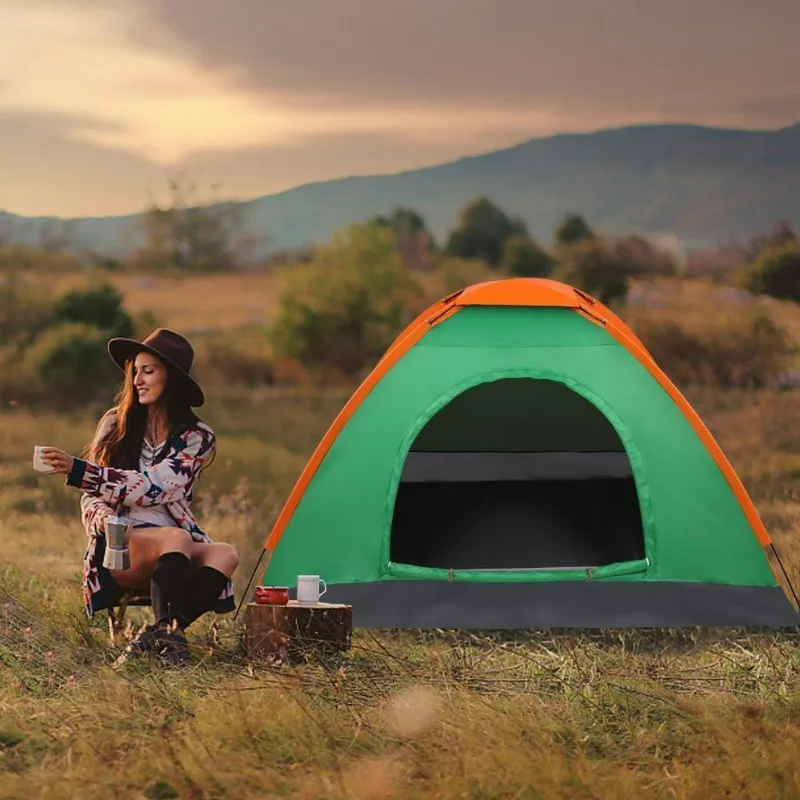
When comparing shelters of similar weight classes, freestanding designs typically offer more functional interior space than their non-freestanding counterparts. This makes 2-person camping tents with freestanding designs particularly appealing for couples or friends who value having adequate personal space without feeling confined.
The enhanced interior volume creates a shelter that feels like a comfortable temporary home rather than merely a place to sleep—an important distinction for many hikers who view their camp setup as part of the overall outdoor experience.
Superior Condensation Management: Staying Dry From Within
Condensation is an unavoidable challenge in all outdoor shelters—the result of warm, moist air from breathing and evaporation meeting cooler tent surfaces. Freestanding shelters, particularly those with double-wall designs, offer significant advantages in managing this moisture.
The double-wall construction creates a comprehensive moisture management system:
- Inner breathable layer allows water vapor to pass through
- Air gap between layers provides thermal buffering
- Outer waterproof rainfly prevents external moisture while allowing condensation to run down rather than drip
- Strategic venting options facilitate air exchange
This system effectively creates a moisture barrier that keeps condensation from transferring to your sleeping bag, clothing, and other gear. Many freestanding shelters feature additional condensation-fighting design elements like mesh panels, adjustable vents, and vestibule configurations that enhance airflow.
The benefits become most apparent in challenging conditions like humid environments, temperature fluctuations between day and night, and multi-day rainy periods when drying opportunities are limited. Waking up with dry gear rather than moisture-laden fabrics significantly improves comfort and safety, especially in cooler conditions.
Modern ultralight freestanding tents have made impressive progress in incorporating these condensation management features while reducing overall weight—addressing the traditional objection that freestanding designs must be heavy to offer these benefits.
For extended trips or variable weather conditions, the superior moisture management of freestanding shelters can prove invaluable in maintaining comfort and preventing the progressive dampening of gear that can make longer adventures miserable.
Versatile Configuration Options: One Shelter, Multiple Modes
Many modern freestanding shelters offer remarkable adaptability through multiple setup configurations, effectively providing several shelter options in a single package. This versatility allows you to optimize your setup for specific conditions and preferences.
Common configuration options include:
- Complete setup – Inner tent body with full rainfly for maximum protection
- Rainfly-only pitch – Some models allow setting up just the rainfly with the pole structure for a lighter option (check specific tent capabilities)
- Inner tent only – Using just the mesh body for bug protection and stargazing on clear, warm nights
- Partial rainfly deployment – Rolling back portions of the rainfly for ventilation while maintaining some protection
This flexibility extends the shelter’s usability across different seasons, weather conditions, and camping scenarios. During warm, bug-free nights, you might opt for a minimalist setup, while quickly transitioning to full protection when weather deteriorates.

The ability to adapt to changing conditions with a single shelter system represents significant value, especially when considering the initial investment. Rather than purchasing specialized shelters for different scenarios, a versatile freestanding design can serve multiple purposes effectively.
Understanding the differences between freestanding vs. staked hiking shelters helps appreciate this adaptability advantage. While non-freestanding designs prioritize weight savings, they often lack the configuration flexibility that makes freestanding options so versatile.
For those seeking balance between weight and versatility, modern lightweight backpacking tents offer impressive adaptability while remaining reasonably portable—making them excellent options for hikers who encounter variable conditions.
Easier Maintenance: Simplifying Camp Cleanup
Freestanding shelters offer significant maintenance advantages that enhance both daily use and long-term care. The ability to lift and manipulate the entire structure makes cleaning and maintenance tasks substantially easier.
This design advantage simplifies several common camp maintenance scenarios:
- Daily cleanup: Easily lift and shake out dirt, sand, pine needles, and other debris that accumulates through normal use
- Morning moisture management: Lift the tent to allow airflow underneath, helping dry morning condensation on the tent floor
- End-of-trip care: Thoroughly clean the shelter before packing to prevent abrasive particles from damaging fabrics during storage
- Damage inspection: Easily examine the entire footprint and structure for potential wear points or damage requiring repair
The ability to perform these maintenance tasks more effectively contributes directly to the longevity of your shelter. Removing abrasive particles regularly prevents premature wear, while identifying and addressing minor damage early prevents more serious failures later.
For those who invest in quality outdoor equipment, this maintenance advantage helps protect that investment. The different types of freestanding shelters for hiking vary in their specific designs, but all share this fundamental maintenance benefit compared to non-freestanding alternatives.
Taking a few minutes each day to lift and clean your shelter can significantly extend its usable life—making the freestanding design an advantage not just for immediate comfort but for long-term value as well.
Lightweight Backpacking Tent, Ultralight Backpacking Tent, Ultralight Bivy Tent
Ultralight Single Person Camping Tent with Aluminum Poles for 3-Season Backpacking Waterproof DesignPrice range: $94.88 through $326.82 Select options This product has multiple variants. The options may be chosen on the product pageTall / Stand Up Camping Tent, Two Room Camping Tent
$407.93 Select options This product has multiple variants. The options may be chosen on the product pageLightweight Backpacking Tent, Ultralight Backpacking Tent, Waterproof Backpacking Tent
$391.05 Select options This product has multiple variants. The options may be chosen on the product pageCompact Backpacking Tent, Lightweight Backpacking Tent, Waterproof Camping Tent
$335.52 Select options This product has multiple variants. The options may be chosen on the product pageCamping Tent with Vestibule, Waterproof Camping Tent
Price range: $407.89 through $479.48 Select options This product has multiple variants. The options may be chosen on the product pageHeavy Duty 4 Season Tent, Ultralight Freestanding Tent, Winter Camping Tent
$3,722.66 Select options This product has multiple variants. The options may be chosen on the product page
Understanding the Trade-offs: Weight, Pack Size, and Cost
While freestanding shelters offer numerous advantages, they come with certain trade-offs that should be considered when making your selection. Understanding these factors helps balance the benefits against potential drawbacks for your specific needs.
The primary considerations include:
Weight: Freestanding shelters typically weigh more than minimalist non-freestanding alternatives. The poles and more robust materials that create their structure add ounces or pounds to your pack weight.
Packed Size: The rigid pole structures require more pack space than trekking pole shelters or simpler designs. The poles themselves typically don’t compress like fabric components.
Cost: The more complex design and additional materials generally result in higher prices compared to simpler shelter systems of similar capacity.
Complexity: More components mean more potential failure points, though modern materials have significantly improved durability.
However, these traditional gaps are narrowing as materials and design innovations continue to advance. Today’s freestanding shelters are significantly lighter than those from just a decade ago, with some approaching the weights of trekking pole-supported shelters that were once dramatically lighter.
Rather than viewing these as absolute disadvantages, consider them as part of the decision-making process. The extra weight might be well worth carrying if you frequently camp on challenging surfaces or value the enhanced livability for longer trips.
When evaluating shelters, consider how these factors align with your personal priorities and typical hiking environments. The “best” choice varies significantly based on individual needs and preferences rather than universal standards.
Who Benefits Most: Is a Freestanding Shelter Right for You?
Freestanding shelters offer clear advantages for specific hiking styles and scenarios. Understanding if your needs align with these strengths helps determine if this shelter type is the right choice for your adventures.
Freestanding designs typically benefit:
- Varied-terrain hikers who regularly encounter challenging surfaces like rock, sand, or platforms where staking is difficult
- Beginner backpackers who appreciate intuitive setup without requiring specialized staking techniques
- Comfort-oriented hikers who prioritize livability and interior space over absolute weight minimization
- All-weather adventurers who face unpredictable conditions requiring robust structural support
- Long-trip backpackers who spend extended time in their shelter and value the additional comfort
- Shared-shelter users where the additional space improves compatibility between tent partners
Your individual priorities significantly influence whether the freestanding advantages outweigh the additional weight and bulk. For example, a weekend backpacker primarily hiking in forests with soft ground might find a non-freestanding ultralight option perfectly adequate, while someone doing a desert thru-hike would likely appreciate the freestanding advantages immensely.
The comprehensive guide to freestanding hiking shelters explores these use cases in greater detail, helping match shelter types to specific hiking styles. The goal isn’t to determine which shelter style is universally “better,” but rather which aligns best with your specific needs and preferences.
Making Your Decision: Key Considerations for Your Next Shelter Purchase
Selecting the ideal shelter requires thoughtful consideration of your specific needs, priorities, and typical hiking environments. Use these questions to evaluate whether a freestanding shelter aligns with your outdoor experiences:
What terrain do you typically encounter? If you frequently camp on challenging surfaces like rock, sand, or platforms, freestanding advantages become more valuable.
How important is setup simplicity? If you often set up camp in darkness, poor weather, or when exhausted, the straightforward assembly of freestanding designs offers significant benefits.
Do you prioritize interior comfort? For longer trips or if you spend substantial time in your shelter beyond just sleeping, the enhanced livability of freestanding designs may justify extra weight.
What weather conditions do you regularly face? If you encounter strong winds or need reliable protection in variable conditions, the structural stability of freestanding shelters provides important security.
How does weight factor into your overall pack strategy? Consider whether the benefits justify the additional ounces within your complete gear system.
The “best” shelter isn’t determined by current trends or the lightest specifications—it’s the one that best serves your particular needs. Many experienced hikers maintain multiple shelter options for different trip types, selecting the most appropriate for each specific adventure.
At Explore Elements, we offer a range of premium freestanding shelters designed to balance protection, comfort, and portability. Our team thoroughly tests each model in diverse environments to ensure reliable performance when you need it most. Remember that the right shelter becomes an essential partner in your outdoor experiences, making the selection process worth careful consideration.

